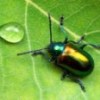Azteca instabilis, Guatemala
An urgent bleg to Myrmecos readers:
If you have recent collections of Azteca ants suitable for molecular work, and you can mail them out within the week, please consider sending me any samples you can spare. I'd be especially grateful for species like Azteca instabilis, A. trigona, or A. velox that do not live in Cecropia.
Why the rush? I am writing an NSF grant with a group of ecologists and plant systematists to look at evolutionary patterns in the famous Cecropia-Azteca ant-plant system. To make our case to NSF we need preliminary data as a proof of concept.
Our intrepid Cecropia collaborators have dozens of their taxa ready to go. On the ant side we are a little behind, with only about 15 samples usable for genetic research. The test set of taxa already makes promising trees with just a pair of loci, but our sample size is still low and very biased towards the Cecropia-nesters. If we could beef it up with about 5-10 more non-Cecropia species we think we'll have a better shot at getting funded. The submission deadline is in January, but we'll need at least two weeks to get the DNA extracted, amplified, and analyzed. Hence the urgency.
Please contact me if you think you can help. This is an exciting project- the ant-Cecropia relationship is an iconic element of Neotropical rainforests, and we may have an opportunity to learn about when, where, and why it originated.
[update: Also, anyone who contributes specimens will get a free 8x10 print, of their choosing, from my photo archive. That's how happy I'd be to get specimens.]

I'll ask my Mexican colleagues around. Don't get too excited though.
Thanks, Roberto!
And in case you're wondering- in spite of appearances from this bleg-there is a morphological component to the project. I'm particularly interested in the evolution of head and jaw form as Azteca transitions among the various nesting types and ant-plant relationships.
Oh, the fact that I am a morphology lover doesn't make me a molecular hater, but the other way around... wait, that doesn't makes sense at all.
Anyway, I'm here just for the free print.
Looking through mandibles across ants I have noticed that there is a special way in which the mandibular blades bend forward and down that seems to be correlated with plant boring habits. This surely occurs at the level of genera (e.g., Tetraponera, Crematogaster, Procryptocerus, Metapone). I haven't look at Azteca closely, and I'm not sure if this kind of modification is so plastic as to follow a pattern of closely related groups of species moving in and out (?) from obligatory arboreal habits.
We can talk more about this later.
Alex,
sorry that I'd not seen this a few weeks earlier. I have TONS of Azteca instabilis from Chiapas and would still be happy to send some along if you still need them. FYI - any of us from the Michigan / Toledo group (e.g. Perfecto, Vandermeer, Philpott, etc.) usually have a bunch.
-Stacy
Thanks Stacy! We have enough specimens for our preliminary phylogeny, but if we do get funded we'd love to include samples of your material in the full project. I'll keep you posted.